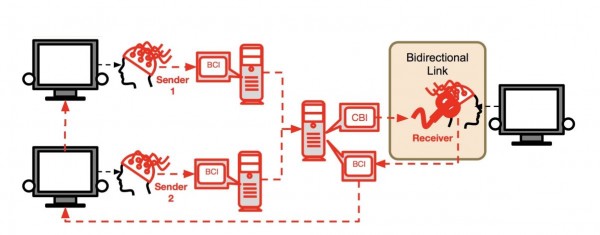BrainNet allows collaborative problem-solving using direct brain-to-brain communication.
The ability to send thoughts directly to another person’s brain is the stuff of science fiction. At least, it used to be.
In recent years, physicists and neuroscientists have developed an
armory of tools that can sense certain kinds of thoughts and transmit
information about them into other brains. That has made brain-to-brain
communication a reality.
These tools include electroencephalograms (EEGs) that record electrical activity in the brain and transcranial magnetic stimulation (TMS), which can transmit information into the brain.
These tools include electroencephalograms (EEGs) that record electrical activity in the brain and transcranial magnetic stimulation (TMS), which can transmit information into the brain.
In 2015, Andrea Stocco and his colleagues at the University of
Washington in Seattle used this gear to connect two people via a
brain-to-brain interface. The people then played a 20 questions–type
game.
An obvious next step is to allow several people to join such a conversation, and today Stocco and his colleagues announced they have achieved this using a world-first brain-to-brain network. The network, which they call BrainNet, allows a small group to play a collaborative Tetris-like game.
“Our results raise the possibility of future brain-to-brain interfaces that enable cooperative problem-solving by humans using a ‘social network’ of connected brains,” they say.
The technology behind the network is relatively straightforward. EEGs measure the electrical activity of the brain. They consist of a number of electrodes placed on the skull that can pick up electrical activity in the brain.

A key idea is that people can change the signals their brain produces relatively easily. For example, brain signals can easily become entrained with external ones. So watching a light flashing at 15 hertz causes the brain to emit a strong electrical signal at the same frequency. Switching attention to a light flashing at 17 Hz changes the frequency of the brain signal in a way an EEG can spot relatively easily.
TMS manipulates brain activity by inducing electrical activity in specific brain areas. For example, a magnetic pulse focused onto the occipital cortex triggers the sensation of seeing a flash of light, known as a phosphene.
Together, these devices make it possible to send and receive signals directly to and from the brain. But nobody has created a network that allows group communication. Until now.
Stocco and his colleagues have created a network that allows three individuals to send and receive information directly to their brains. They say the network is easily scalable and limited only by the availability of EEG and TMS devices.
The proof-of-principle network connects three people: two senders and one person able to receive and transmit, all in separate rooms and unable to communicate conventionally. The group together has to solve a Tetris-like game in which a falling block has to be rotated so that it fits into a space at the bottom of the screen.
The two senders, wearing EEGs, can both see the full screen. The game is designed so the shape of the descending block fits in the bottom row either if it is rotated by 180 degrees or if it is not rotated. The senders have to decide which and broadcast the information to the third member of the group.
To do this, they vary the signal their brains produce. If the EEG picks up a 15 Hz signal from their brains, it moves a cursor toward the right-hand side of the screen. When the cursor reaches the right-hand side, the device sends a signal to the receiver to rotate the block.
The senders can control their brain signals by staring at LEDs on either side of the screen—one flashing at 15 Hz and the other at 17 Hz.
The receiver, attached to an EEG and a TMS, has a different task. The receiver can see only the top half of the Tetris screen, and so can see the block but not how it should be rotated. However, the receiver receives signals via the TMS from each sender, saying either “rotate” or “do not rotate.”
The signals consist of a single phosphene to indicate the block must be rotated or no flash of light to indicate that it should not be rotated. So the data rate is low—just one bit per interaction.
Having received data from both senders, the receiver performs the action. But crucially, the game allows for another round of interaction.
The senders can see the block falling and so can determine whether the receiver has made the right call and transmit the next course of action—either rotate or not—in another round of communication.
This allows the researchers to have some fun. In some of the trials they deliberately change the information from one sender to see if the receiver can determine whether to ignore it. That introduces an element of error often reflected in real social situations.
But the question they investigate is whether humans can work out what to do when the data rates are so low. It turns out humans, being social animals, can distinguish between the correct and false information using the brain-to-brain protocol alone.
That’s interesting work that paves the way for more complex networks. The team says the information travels across a bespoke network set up between three rooms in their labs. However, there is no reason why the network cannot be extended to the Internet, allowing participants around the world to collaborate.
“A cloud-based brain-to-brain interface server could direct information transmission between any set of devices on the brain-to-brain interface network and make it globally operable through the Internet, thereby allowing cloud-based interactions between brains on a global scale,” Stocco and his colleagues say. “The pursuit of such brain-to-brain interfaces has the potential to not only open new frontiers in human communication and collaboration but also provide us with a deeper understanding of the human brain.”
Fascinating stuff!
Ref: arxiv.org/abs/1809.08632: BrainNet: A Multi-Person Brain-to-Brain Interface for Direct Collaboration Between Brains
